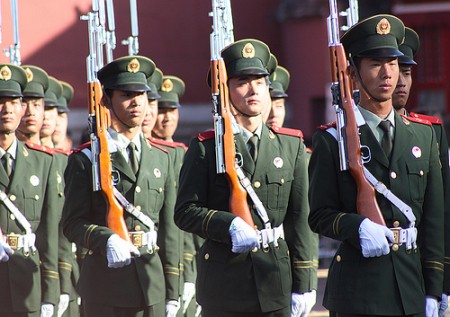Stokes writes that the Chinese Communist Party’s Central Military Commission “maintains strict control over China’s operational nuclear warheads through a centralized storage and handling system managed by the People’s Liberation Army (PLA) Second Artillery.” In peacetime, warheads are managed through a system that is “separate and distinct” from PLA Second Artillery missile bases as well as apart from China’s system for keeping tabs on its civilian-use fissile materials. In addition, he says, the Second Artillery appears to control and manage nuclear warheads that could be used by the PLA’s air force and navy.
According to Stokes, “an independent organization known as 22 Base is responsible for storing and managing most of the Second Artillery’s nuclear warhead stockpile.” The main storage complex is located (underground) in Taibai County, Shaanxi Province, in central China – deep in the Qinling mountain range. “With missile bases possessing only a limited number of warheads at any given time,” most are kept here.
But movement of warheads happens often, Stokes suggests, noting that the mobility of its nuclear arsenal is “critical to [China’s] nuclear deterrent and warfighting capability.” Warheads “appear to be circulated back and forth between the central storage complex in Taibai and six smaller storage facilities” around the country. In general, warhead transfers use China’s road and rail network (air transport is apparently only used in extreme circumstances) and usually take place at night, to avoid attracting unwanted attention.
Security at the Taibai complex is second to none. Physical protection measures highlighted by Stokes include real-time video monitoring, an infrared security system, fingerprint access mechanisms, a computerized warhead accounting system, temperature and humidity controls, fire-fighting equipment, and advanced communications linking different parts of the facility. There is, in addition, a dedicated security battalion – including a cavalry company for patrolling the mountainous terrain around the complex. Indeed, Stokes writes, “Taibai may be one of the most secure stockpile facilities in the world.”
Overall, he judges, China adopts a “responsible and serious attitude” to nuclear safety and security. Welcome news ahead of next month’s nuclear security summit in Washington, DC. But “with warheads most vulnerable to theft or accident during transportation, the system’s reliance on mobility creates opportunities for incidents and terrorist action.” And in these days of indiscriminate global jihadism, the old maxim of Brian Jenkins, that terrorists “want a lot of people watching and a lot of people listening and not a lot of people dead,” is regrettably obsolete.
Remember to check out the March Special Issue newsletter on the prospects of a nuclear weapons free world.


